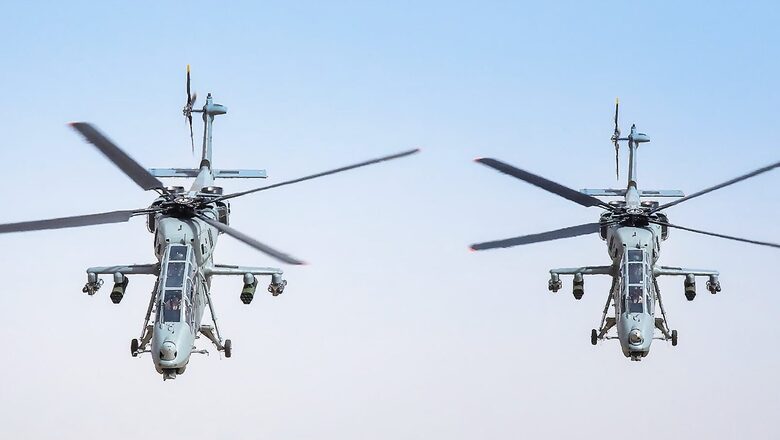
views
In a push to its combat prowess, the Indian Air Force (IAF) on Monday inducted the first batch of indigenously developed Light Combat Helicopters (LCH). The multi-role platform can fire a variety of missiles and other weapons.
The LCH, developed by the state-owned Hindustan Aeronautics Ltd (HAL), is primarily intended for use in high-altitude environments.
It was inducted into the IAF at a ceremony in Jodhpur in the presence of Defence Minister Rajnath Singh and Chief of Air Staff Air Chief Marshal VR Chaudhari.
The 5.8-tonne twin-engine helicopter, Prachand, has already completed various weapons firing tests.
नाम है ‘प्रचंड’ pic.twitter.com/dCa3WGvw9A— Rajnath Singh (@rajnathsingh) October 3, 2022
A look at the other defence equipment procured or in the process under the ‘Make in India’ Abhiyaan:
SWARM DRONES, LIGHT TANKS, UAVS:
Zorawar
#Innovation #Integration #IntimidationHarnessing indigenous talent and technological capability, IAF is leading the way in using Artificial Intelligence to add to its combat potential. Swarm drones is a prime example. #IndianAirForce#HarKaamDeshKeNaam pic.twitter.com/gZV8lKK4yS— Indian Air Force (@IAF_MCC) December 5, 2020
The Army is procuring a range of unmanned aerial vehicles (UAVs) for surveillance and target acquisition purposes, including loitering munitions for combat roles, for its artillery units deployed along India’s borders with China and Pakistan, News18 recently reported.
This includes an unspecified number of mini UAVs for which internal deliberations are at an advanced stage and also loitering munitions which the Army bought last year under emergency procurement.
As per sources, the UAVs will aid the Observation Post (OP) Officers and Forward Observation Officers (FOO) with information gathered through surveillance in advance. Sources said the mini UAVs will have a range varying from 15-20 km to 75-90 km with matching endurance and will be employed for engagement of targets in tactical and depth areas. The loitering munitions—which are unmanned combat aerial vehicles (UCAVs)—can loiter in the air and close on the designated target and attack it by self-destructing onto it when directed.
ATAGS: The Army will soon initiate the process of procuring 100 additional K9 Vajra-T 155 mm/52 calibre tracked self-propelled gun systems. The 155mm, 39-calibre towed artillery guns can be airlifted by the Chinook helicopters at a short notice and swiftly deployed at the borders.
The Advanced Towed Artillery Gun System (ATAGS) which has been developed by the Defence Research Development Organisation (DRDO) and manufactured in collaboration with collaborated with Bharat Forge Limited and Tata Advanced Systems Ltd has completed a range of extensive trials.
Defence sources said the life and technology of the 130 mm indigenous Sharang gun system is enhanced to make it a successful “upgunned" gun with better range and accuracy.
AHSP Transfer of Pinaka Weapon System from DRDO to DGQAhttps://t.co/gbIM7IBfSJ pic.twitter.com/LyktTbTqGq— DRDO (@DRDO_India) September 25, 2020
INS VIKRANT: On September 2, 2022, the Indian Navy, in the presence of Prime Minister Narendra Modi, commissioned INS Vikrant, the first indigenous aircraft carrier built at the cost of Rs 23,000 crore. Work on INS Vikrant’s design began in 1999 and its foundation was laid in 2009; its basin and sea trials have been completed as of now.
SWATHI: The indigenous weapon locating radar Swathi has been inducted and deployed along the northern borders. A counter-battery radar designed to detect and track incoming artillery and rocket fire, Swathi can assess the point of origin for counter bombing.
Weapon Locating Radar (WLR)- SWATHI, jointly made by LRDE, @DRDO_India & BEL from Indian Army’s Surveillance And Target Acquisition Regiment will be displayed at the 69th #RepublicDay Parade.Watch out for this tableau at the 69th #RepublicDay Parade pic.twitter.com/23djCz3Mgy
— रक्षा मंत्री कार्यालय/ RMO India (@DefenceMinIndia) January 24, 2018
TEJAS: The Centre has given its nod to the development of the next-generation variant and a more potent version of the indigenous light combat aircraft (LCA) Tejas – Tejas Mark-2.
Flight testing and certification of the Tejas Mark-2 project would cost Rs 6,500 crore, in addition to the Rs 2,500 crore earlier sanctioned for it, reports indicate.
AK-203 RIFLES: India has signed a deal for AK-203 assault rifles with Russia. The deal for the production of over 6 lakh Ak-203 rifles is set to be worth over Rs 5,000 crore.
The production of the AK-203 will be undertaken in India by the Indo-Russia Rifles Pvt Ltd (IRRPL), which was created as a joint venture between the Ordnance Factories Board (OFB) and the Russian entities Rosoboronexport and Concern Kalashnikov. OFB holds 50.5 per cent stake in the concern with the Russian entities accounting for the remaining 49.5 per cent share.
#KnowYourArmy#IndianArmy undertakes operational deployment of the state of art #Dhanush Gun System. It is the first indigenous development project for long range towed Artillery Guns.#AtmaNirbharBharat pic.twitter.com/kj8Tjv5x6H— ADG PI – INDIAN ARMY (@adgpi) September 28, 2022
Other indigenous equipment includes Dhanush guns, Arjun tank, Astra missile and Akash missile.
Read all the Latest News India and Breaking News here




















Comments
0 comment